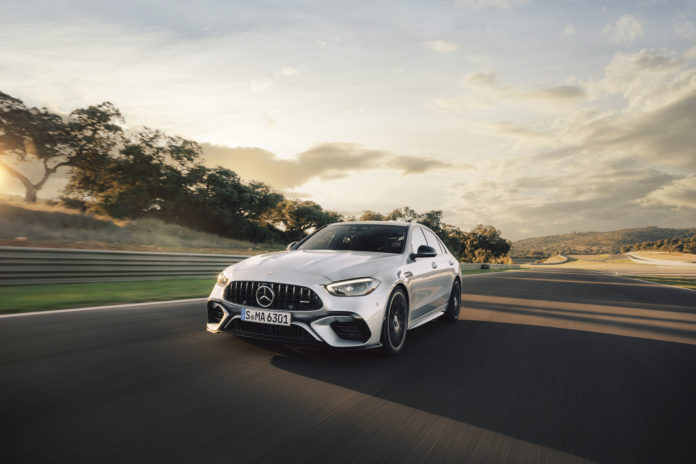I’m entering a fast right-hander on Circuito Ascari in southern Spain in the 2024 Mercedes-Benz AMG C 63 S E Performance and the squawk from the tires quickly becomes a four-wheel slide. It’s a short, controllable slide, but no slide is ideal for fast lap times.
There are a few reasons for the slide. First, I came into the corner a little hot, but that’s easy to do with 671 hp at my disposal. Second, the 265/45R20 front and 275/35R20 rear Michelin Pilot Sport 4 S tires make for a fine set of performance rubber, but this car could use a stickier tire for this smooth, roughly 2.5-mile track. Third, and most importantly, this car is just plain heavy.
The alphabet soup that is the 2024 Mercedes-Benz AMG C 63 S E Performance—can we just call it the C63 E for cripe’s sake?—trades a rowdy twin-turbo V-8 for a sophisticated turbo-4 plug-in hybrid setup and gains 780 pounds in the process. The change makes the car faster in a straight line and even on a track, but it relies on clinical technology instead of light weight and brute force to do so.
2024 Mercedes-Benz AMG C 63 S E Performance
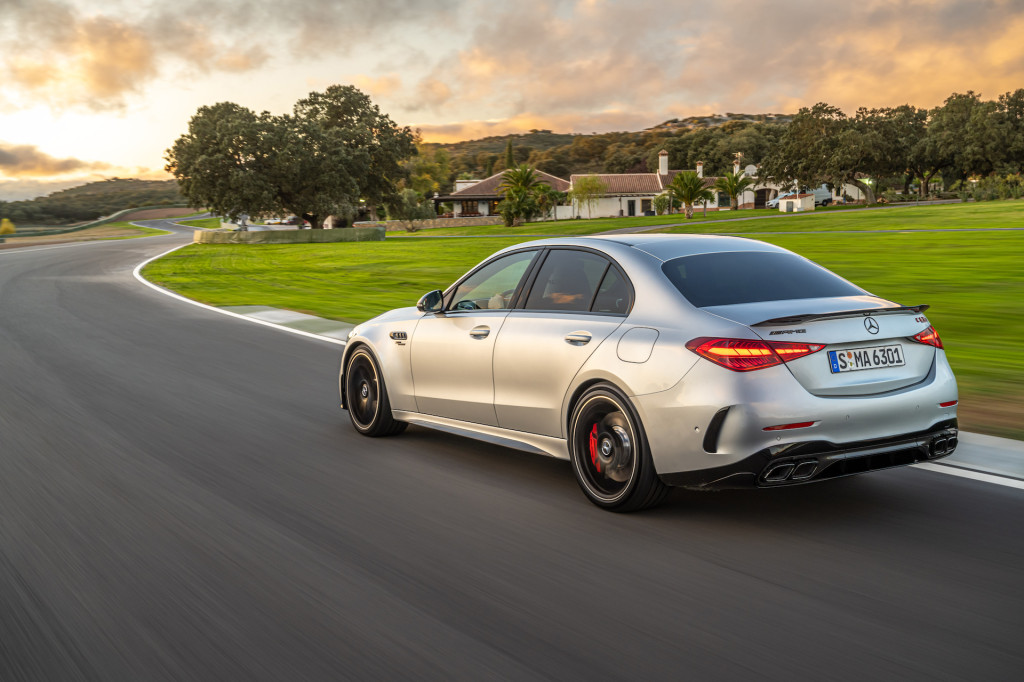
2024 Mercedes-Benz AMG C 63 S E Performance
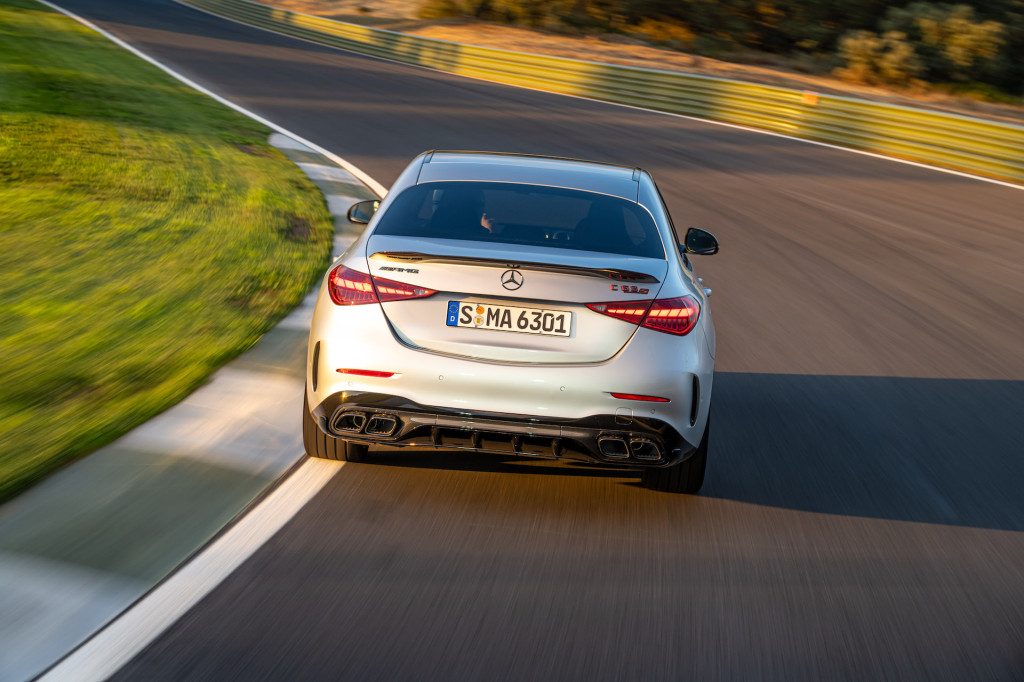
2024 Mercedes-Benz AMG C 63 S E Performance
Mercedes-AMG C 63 S E Performance: Techy and tetchy on the track
Back to that slide. A lot of technology helps me transition from the slide to a sharply executed turn. It starts with the typical stuff standard in the last C 63, like advanced stability control with four levels of adjustment ranging from Basic to Master, and an electronic limited-slip differential to apportion the power efficiently at the rear.
But then there’s the new stuff, and all of it is on the rear axle. The eLSD is accompanied back there by an electric motor that can add up to 201 hp for electric all-wheel drive. It sends its power through a 2-speed transmission that shifts up at 87 mph to deliver the best torque down low and the best power at high speed. The motor revs to 13,500 rpm, so the transmission’s shift point is programmed to get the most out of it in first gear, then allow it to spin all the way up to the car’s 174-mph top speed.
A 6.1-kwh battery, developed by AMG with knowledge from the Formula 1 program, doles out quick shots of energy to the motor and recovers it quickly. It sits above the rear motor and differential. Rear-wheel steering sits back there, too. It can turn up to 2.5 degrees opposite the fronts at 62 mph and below to shorten corners and 0.7 degree with the fronts above that speed to improve stability.
All that equipment at the rear moves the car’s weight around, resulting in a 49:51 front-to-rear weight balance.
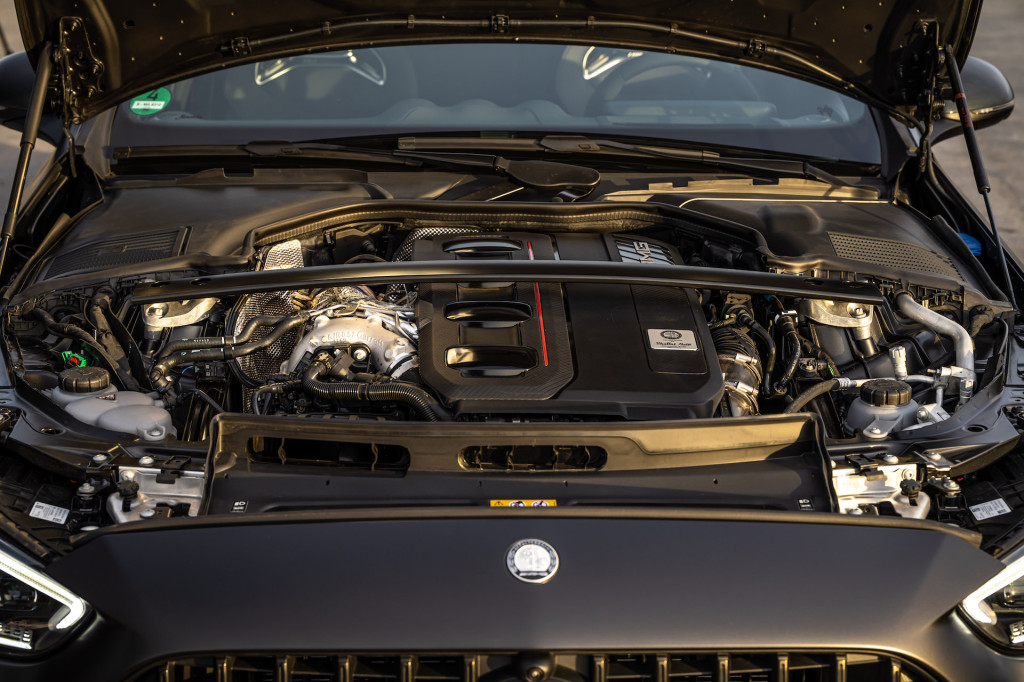
2024 Mercedes-Benz AMG C 63 S E Performance
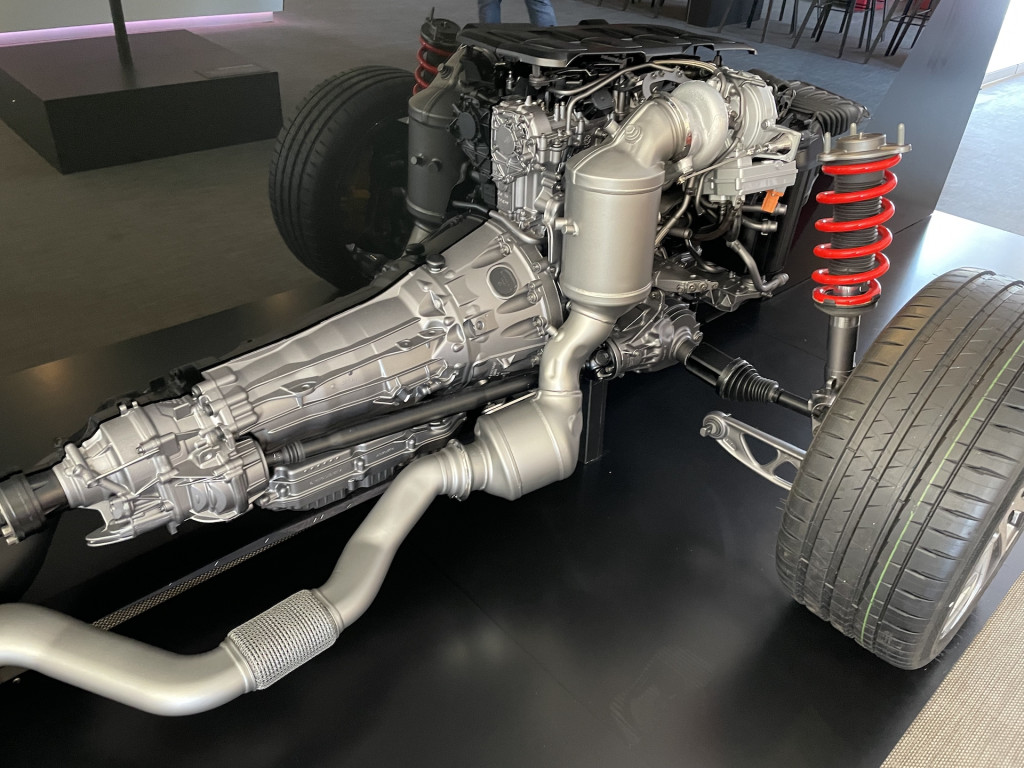
2024 Mercedes-Benz AMG C 63 S E Performance
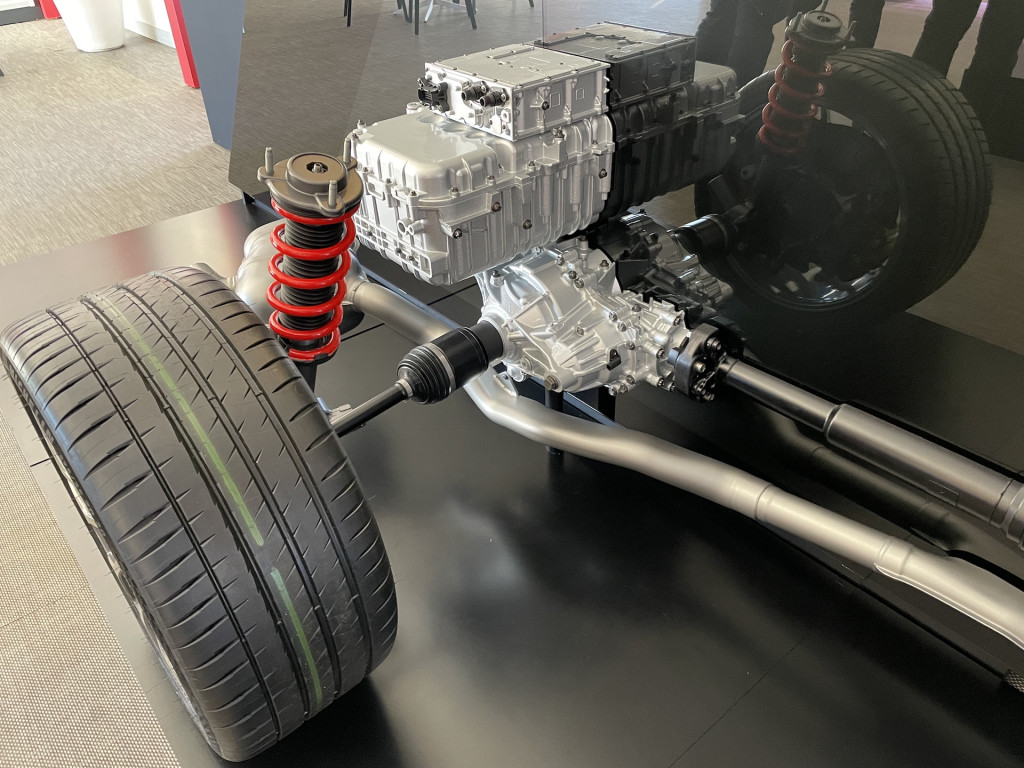
2024 Mercedes-Benz AMG C 63 S E Performance
At the end of each straight, I get the speed under control by stomping on the brakes. The brake pedal feels strong as 6-piston front calipers clamp down on 15.4-inch rotors, and single-piston calipers pinch 14.6-inch rear rotors. The brakes hold up through several track sessions, but they could grip harder, and such a heavy car would be better served by carbon-ceramic brakes for the track. Mercedes says they will be an option.
Once braking puts the weight on the front tires, the car rotates willingly. It even begins to over-rotate when I turn too sharply. While it’s easy to recover, this would be a good way to begin a drift for the available Drift mode. The car turns in quickly through quick, weighty, and stable front-wheel steering. Meanwhile, the rear-wheel steering helps shorten the tighter corners, and the eLSD puts the power down effectively in the middle and out of each corner.
Back on the throttle into the next straight, more technology comes into play. The M139l 2.0-liter turbo-4 from the CLA 45 sedan and GLA 45 crossover SUV sits longitudinally in this car rather than transversely elsewhere. It uses an electric/exhaust gas turbocharger powered by the car’s 400-volt electrical architecture and also developed from F1 technology. The electric power allows the turbo to spool up quickly before the hand-off to exhaust gases. The engine makes 469 hp and 404 lb-ft of torque on its own.
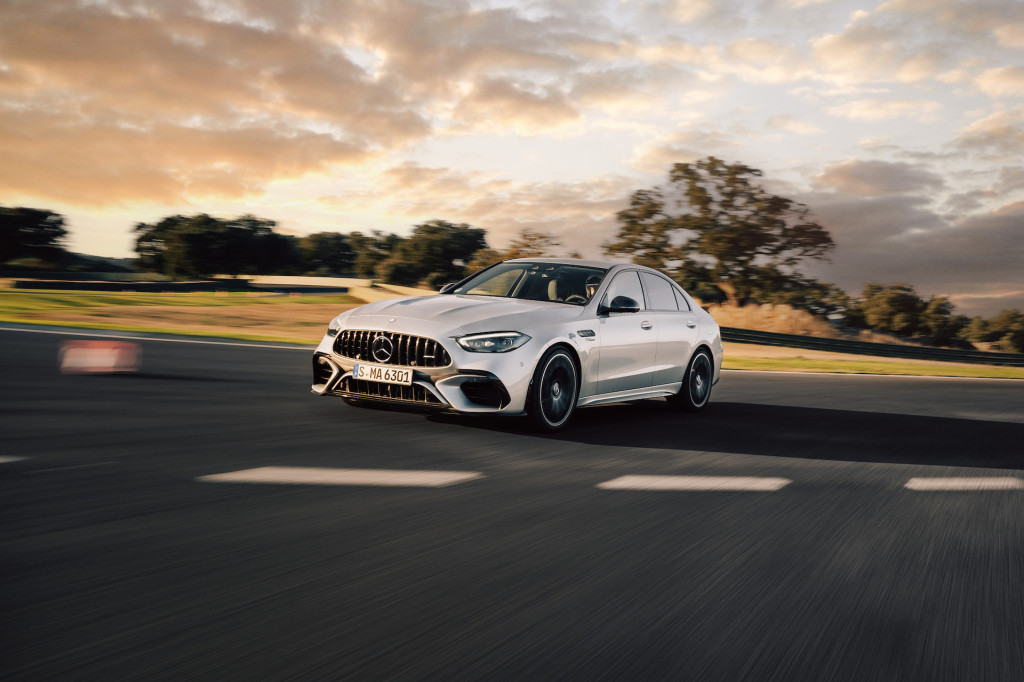
2024 Mercedes-Benz AMG C 63 S E Performance
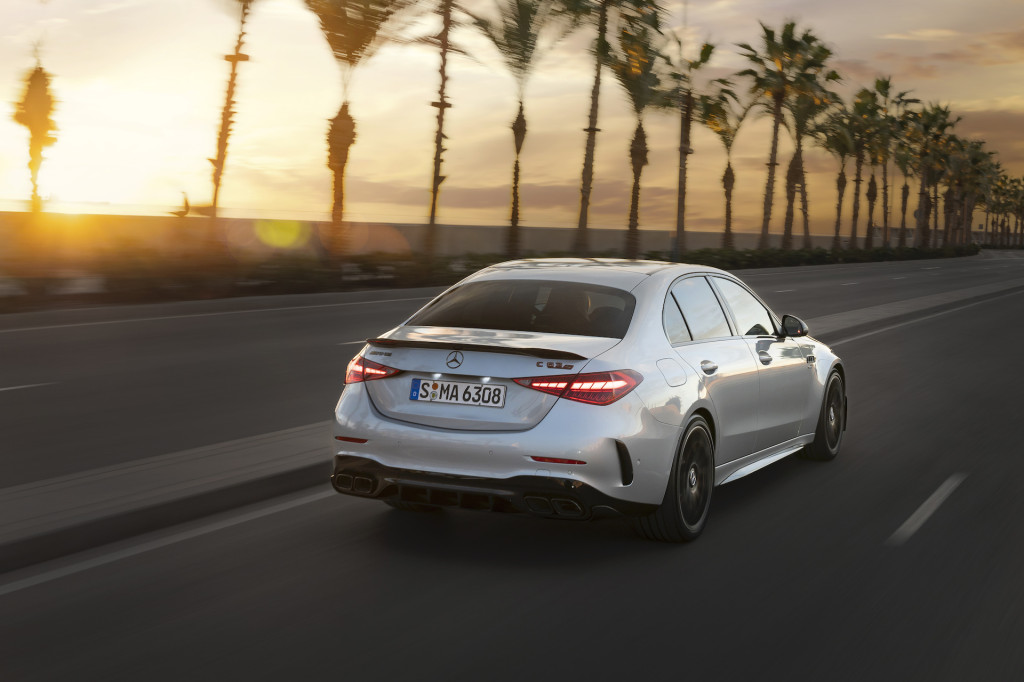
2024 Mercedes-Benz AMG C 63 S E Performance
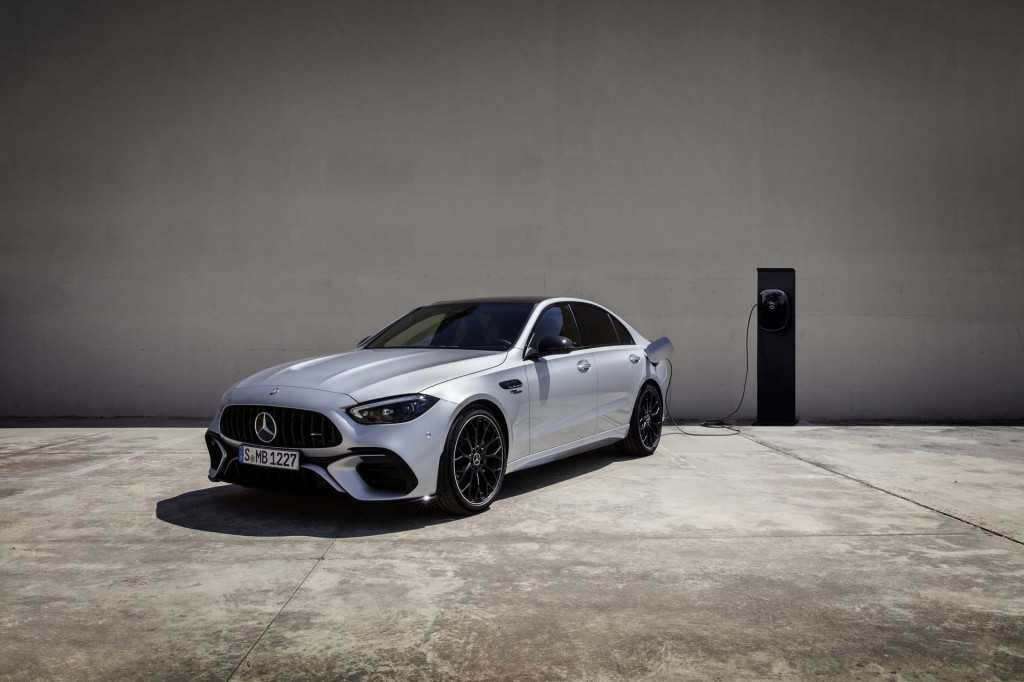
2024 Mercedes-Benz AMG C 63 S E Performance
The electric motor can add up to 201 hp to give the car a maximum of 671 hp—well, sometimes. The motor can always add 94 hp of continuous power, effectively making the C 63 a 563-hp car at any given time. In Comfort and Battery Hold modes, though, the motor adds 25% of its power, or 50 hp for a total of 519 hp. In Sport mode, it adds 65%, or 130 hp, to bring the total to 599 hp. In Sport+ mode and Race mode without kickdown, it adds 80%, or 160 hp, for 629 hp. In any mode, a notched kickdown at the end of the throttle pedal travel unleashes the car’s full power in 10-second intervals.
The power is always at the ready. Between the early spool of the turbo and the shot of power from the rear motor, the C 63 is always ready to slingshot out of corners and stay on boil to the engine’s 7,000-rpm redline. Mercedes quotes a 0-60 mph time of just 3.3 seconds, a half second quicker than the previous-generation C 63 S, which made 503 hp from a twin-turbo 4.0-liter V-8.
The engine’s power flows through a 9-speed automatic transmission that uses a wet clutch instead of a torque converter. It keeps choosing the right gear for the situation on the track, and I soon learn it’s best to let it do the shifting. When I switch to manual shifting, I get out of sorts looking for the paddle shifters because they aren’t very large and they don’t turn with the steering wheel. I quickly switch back to automatic mode.
The power from the rear goes exclusively to the rear wheels when it’s used as an add-on, so the transmission doesn’t have to deal with the force of the car’s full 671 hp and 752 lb-ft of torque.
During this track session, I’m using Mercedes’ Track Pace app, which has been programmed to include Ascari, for optimal power delivery. It’s one of about 20 tracks currently in the app, and that will increase to 70-80 tracks around the world. The app has Hot Lap and Endurance settings to best determine when to make the full electric boost available and keep it available. Each track session includes seven laps, two to get the lay of the track, three hot, and two cooldown. The extra cooldown lap helps recover energy to charge the battery back up near 100% so the motor’s full power is available for the next session. Running in the Hot Lap setting would drain the battery on these longer sessions and sap power on later laps.
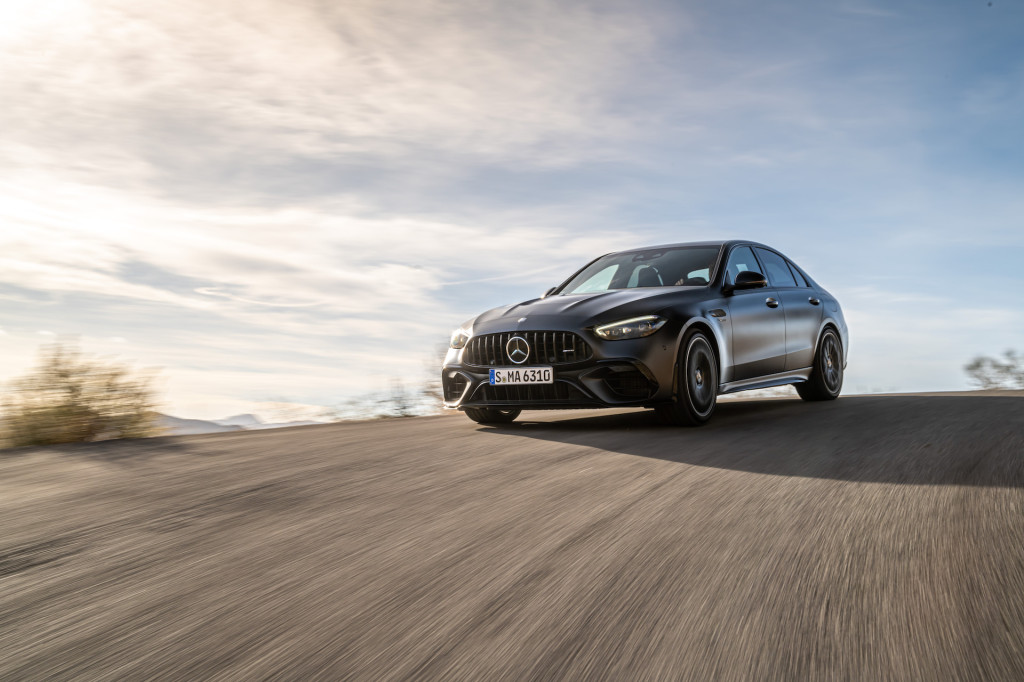
2024 Mercedes-Benz AMG C 63 S E Performance
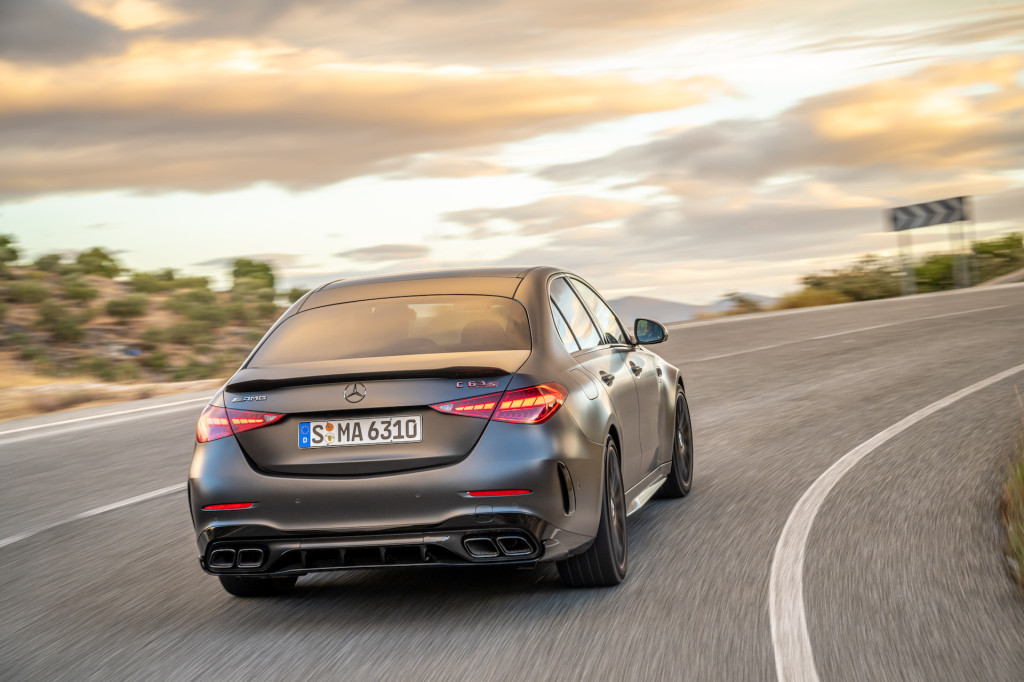
2024 Mercedes-Benz AMG C 63 S E Performance
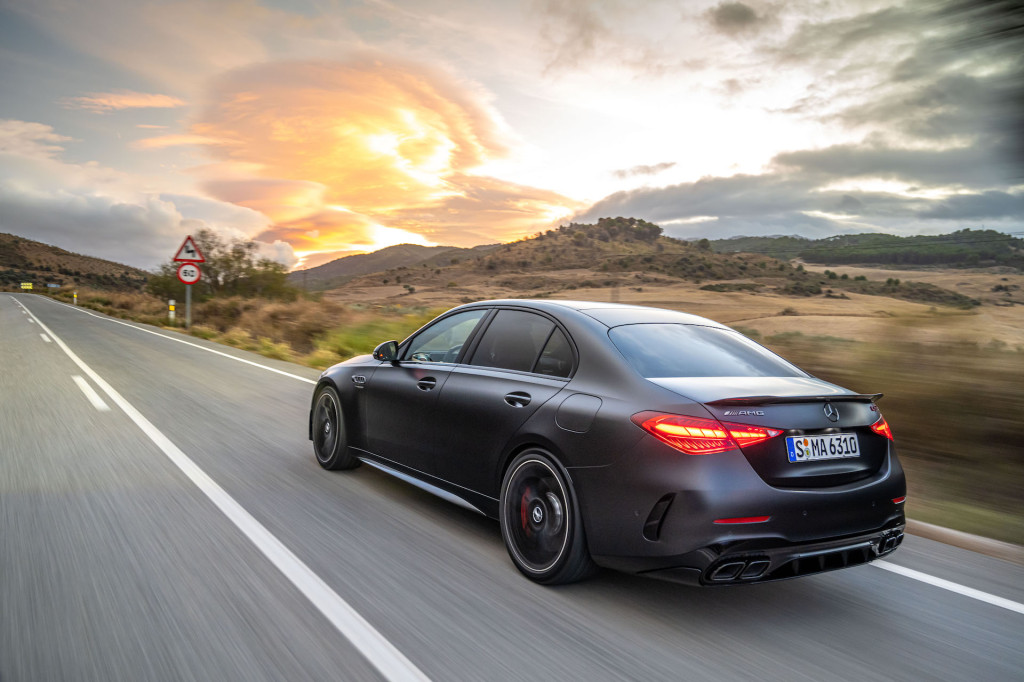
2024 Mercedes-Benz AMG C 63 S E Performance
Mercedes-AMG C 63 S E Performance: A rock (canyon) star
While the new C 63’s weight compromises its track performance, that all changes on the road. Track driving stresses a car at its limits, but anyone driving to a car’s limits on the road is asking for a crash, jail time, or both. It’s that last 10-15% of unchecked aggression that shifts the C 63’s weight on the track, but that doesn’t happen on the street.
Without the pendulum of extra weight, the C 63 feels much more athletic. It turns sharply, leans less, and recovers its weight better for switchbacks. The powertrain’s ready power feels even stronger on the beautiful mountain roads outside Malaga, Spain, where full-throttle bursts aren’t the norm. It’s a grand way to tour these roads, and that’s what the C 63 has become: more of a grand tourer than a super sport sedan.
On the mountain roads the new C 63 simply doesn’t drive as big as it does on the track, even though it’s bigger than a standard C-Class. It’s 3.3 inches longer than the base car, with most of that in the front end, and the wheelbase grows by 0.4 inch. Wider fenders fit big tires, and the front track increases by 2.0 inches. Part of the extra size is due to aerodynamic elements. To better cut through the air, the C 63 has a jet wing-design front fascia backed by two active air panels to control cooling, side skirts, and a large rear diffuser.
The road drive gives me a chance to tune into the car’s new sound. Without the mellifluous thrum of a V-8, the C 63 relies on some audio trickery to keep an appropriately mean soundtrack. Mercedes adds external speakers to give the car a sound when running in Electric mode. These same speakers pick up sound from the engine using a pressure sensor in the exhaust system. That sound is then enhanced and sent through the cabin via the audio system.
If I didn’t know any better, I’d think I’m driving a V-8. The engine doesn’t bellow as deeply as the old V-8, but it’s still low and guttural and it cracks and pops on overrun. It’s louder in Sport+ and Race modes, but other than in Electric mode, it’s a constant companion to remind you this is a performance car. Just don’t think about the fact that it’s mostly fake and it won’t bother you.
The street drive also gives me the opportunity to turn the dial on the right side of the steering wheel to check out driving modes other than Race. Electric mode uses the rear motor exclusively as long as the battery has enough charge and my right foot remains restrained. It’s no fun driving this way. I often start the engine, and it quickly drains the battery and its 8 miles of electric range, so I soon switch to Comfort and Sport modes. They provide more than enough punch, but the shifts in Sport mode are more to my liking to keep the power accessible. Track mode’s quick shifts are too extreme for stop-and-go traffic.
The best mode, however, is Individual. Other than on a track or smooth canyon road, I wouldn’t want the adjustable dampers in anything other than their Comfort setting. Ported over from the AMG GT Black Series, they start out firm and progress to downright stiff. Even in their softest mode, the rear end juts upward over sharp bumps. Individual lets me choose Comfort for the dampers and a sportier mode for the powertrain.
I can also choose from four levels of brake regeneration. In this car, levels 0 and 1, which provide coasting and engine braking, respectively, feel the most natural. Level 3 provides one-pedal driving capability, but only when the battery is low enough to accept a charge. As the battery charge increases, the system often locks me out from Level 3.
The C 63 adds some sporty elements to the C-Class’s already beautiful cabin. Sport seats come standard but our test cars have the optional AMG Performance seats with side bolster cutouts to fit racing harnesses. They’re confining and they’re giving a little love to my love handles, but they’re not too tight for wider backsides.
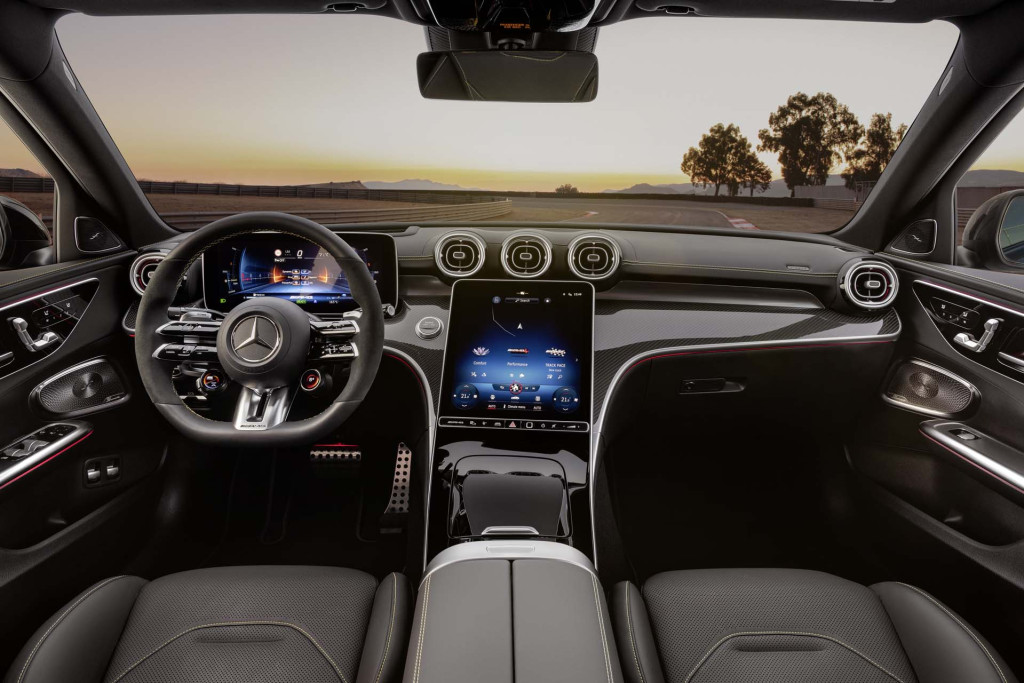
2024 Mercedes-Benz AMG C 63 S E Performance
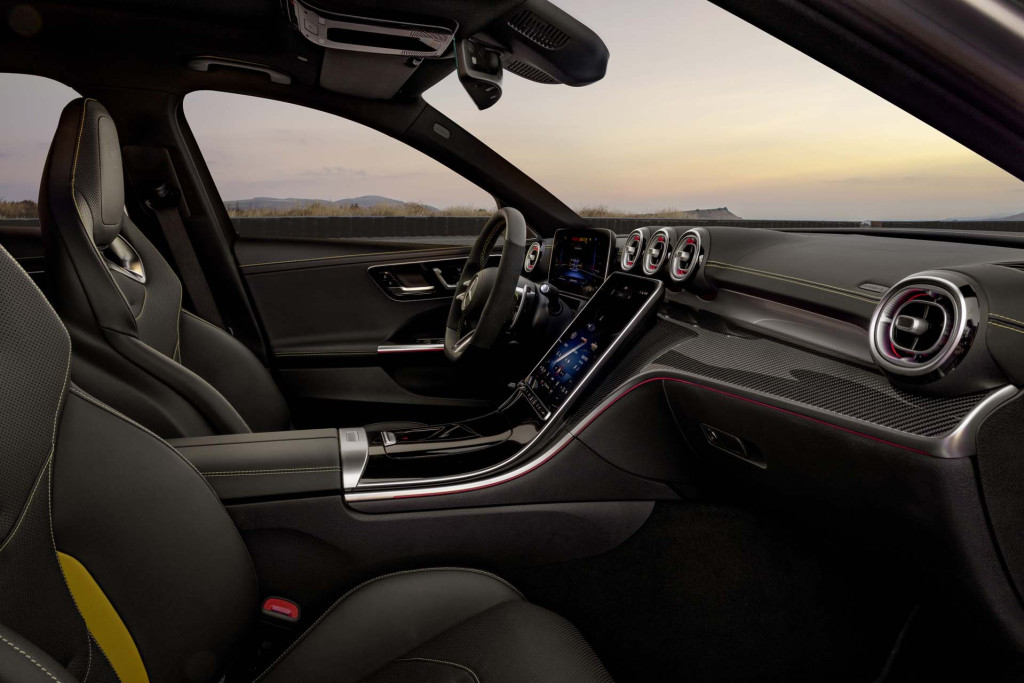
2024 Mercedes-Benz AMG C 63 S E Performance

2024 Mercedes-Benz AMG C 63 S E Performance
The 12.3-inch digital instrument cluster offers seven screen options, including Sport, Supersport, and Track Pace that put more and more performance information front and center. The standard 11.9-inch portrait-style center touchscreen also offers several telemetry readouts.
Pricing isn’t yet available for the 2024 Mercedes-Benz AMG C 63 S E Performance, which is set to go on sale late next summer. However, Mercedes reps suggested about a 10% increase from the outgoing model, which started near $80,000.
The next-generation C 63 future-proofs the brand’s sport sedan for tightening emissions standards, especially in Europe, where it’s rated at 6.9 liters/100 km versus 10.4 liters/100 km for the last model, a 51% improvement. U.S. efficiency ratings aren’t yet available.
Evolution turns what was a rambunctious V-8-powered sport sedan into a clinical and more powerful plug-in hybrid. It drinks less fuel, accelerates faster, and even goes around a track quicker, but it gets heavy and that changes it from a rowdy track car into a technologically advanced grand tourer in the process.
Mercedes-Benz paid for travel, lodging, and track time for Motor Authority to bring you this firsthand report.

